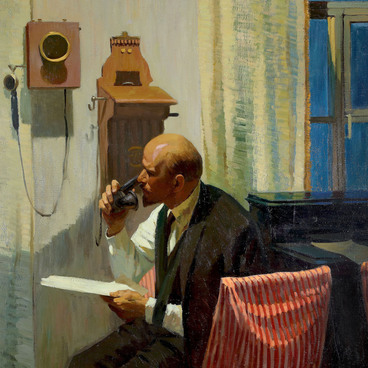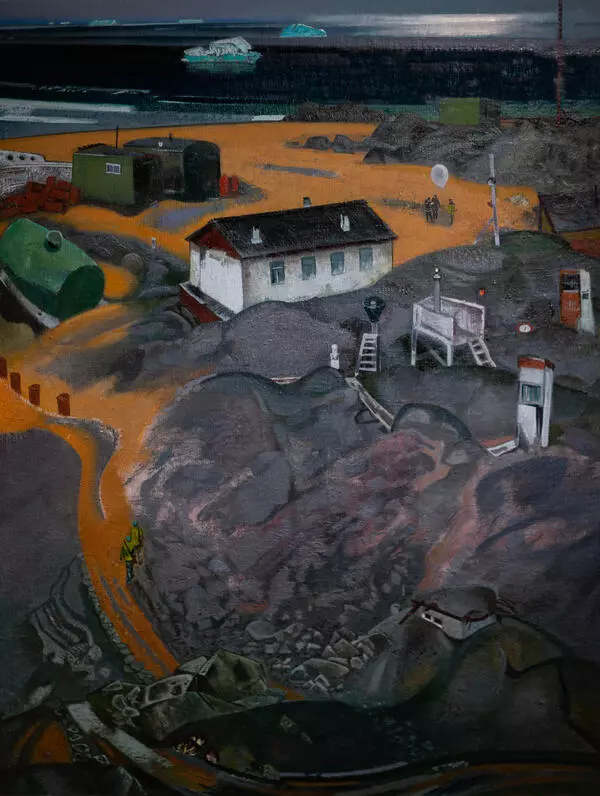The nature of the North and the Ural land was the main theme of the works of Yevgeny Ivanovich Gudin. In his landscapes, the artist strove to reflect on the relationship between humans and nature and depict it. Judging by the nature of his works and the means of expressiveness used in them, the artist was part of the “austere style” movement — a trend in Soviet art of the late 1950s and 1960s.
Gudin had favorite places that he drew strength from, such as Siberia, the Far East, the Polar North, the Amur, Sakhalin, the Kara Sea coast, the Northern and Polar Urals, Bashkiria, Taymyr, Norilsk, Talnakh, Khakassia, Tuva, the Carpathians, Transcarpathia, Kamchatka, the Kuril Islands, and Chukotka. The North with its ice and snow was especially captivating for the artist.
In 1970, Yevgeny Gudin went on a long trip exploring the eastern border outposts stretching from Vladivostok to the Bering Strait. He depicted one of them in his painting “At the Border Outpost”.
The work is performed in a restrained and muted color palette. The landscape depicts a rocky coast covered with boulders and grass. On the left, a cliff rises above the sea. At its foot, there are a few buildings surrounded by severe nature, and there is an observation post with a radar at the top of the cliff. The background shows vast expanses of water and a sailing ship. As a representative of the “austere style”, Gudin employs such artistic means as concise shapes, generalization, clear contours, monumental figures, and large spots of color.
Art critics believe that the painting depicts the easternmost point of Russia — Ratmanov Island of the two Diomede Islands.
Europeans first visited it in the mid-17th century as part of the Dezhnyov expedition. Since the islands were set quite apart from each other and known for the harsh climate, they were discarded. In 1728, the islands were visited by the Vitus Bering expedition. The explorer named them Big and Little Diomede on the day that celebrated the memory of the martyr St. Diomede. At the time, the population of the main island was around 400 inhabitants.
In the early 19th century, the Russian navigator Otto von Kotzebue got a little confused and renamed Big Diomede into Ratmanov Island, and the name stuck.
When Russia sold Alaska to the U.S., the archipelago was divided into two parts, and the Russian-American demarcation line was established between the islands in the middle of the strait. Many Eskimos chose to migrate to the American side. During the Soviet times, local civilians were gradually moved to the mainland, and Ratmanov Island became a border outpost. There has been no indigenous population on the island for a long time now.
Gudin had favorite places that he drew strength from, such as Siberia, the Far East, the Polar North, the Amur, Sakhalin, the Kara Sea coast, the Northern and Polar Urals, Bashkiria, Taymyr, Norilsk, Talnakh, Khakassia, Tuva, the Carpathians, Transcarpathia, Kamchatka, the Kuril Islands, and Chukotka. The North with its ice and snow was especially captivating for the artist.
In 1970, Yevgeny Gudin went on a long trip exploring the eastern border outposts stretching from Vladivostok to the Bering Strait. He depicted one of them in his painting “At the Border Outpost”.
The work is performed in a restrained and muted color palette. The landscape depicts a rocky coast covered with boulders and grass. On the left, a cliff rises above the sea. At its foot, there are a few buildings surrounded by severe nature, and there is an observation post with a radar at the top of the cliff. The background shows vast expanses of water and a sailing ship. As a representative of the “austere style”, Gudin employs such artistic means as concise shapes, generalization, clear contours, monumental figures, and large spots of color.
Art critics believe that the painting depicts the easternmost point of Russia — Ratmanov Island of the two Diomede Islands.
Europeans first visited it in the mid-17th century as part of the Dezhnyov expedition. Since the islands were set quite apart from each other and known for the harsh climate, they were discarded. In 1728, the islands were visited by the Vitus Bering expedition. The explorer named them Big and Little Diomede on the day that celebrated the memory of the martyr St. Diomede. At the time, the population of the main island was around 400 inhabitants.
In the early 19th century, the Russian navigator Otto von Kotzebue got a little confused and renamed Big Diomede into Ratmanov Island, and the name stuck.
When Russia sold Alaska to the U.S., the archipelago was divided into two parts, and the Russian-American demarcation line was established between the islands in the middle of the strait. Many Eskimos chose to migrate to the American side. During the Soviet times, local civilians were gradually moved to the mainland, and Ratmanov Island became a border outpost. There has been no indigenous population on the island for a long time now.



